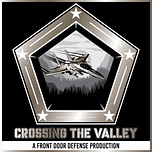In this episode of Crossing the Valley, I had the pleasure of speaking with Jade Baranski, the founder and CEO of Mobilize. Mobilize is a company that connects end users within the federal government to the companies that provide the capabilities they need.
Jade shares the story of how VISION came to be, starting with their participation in an Air Force pitch competition, with twists turns and pivots along the way. The end result is Vision, a data platform, has changed the way data is used in the defense “innovation” and acquisition communities to match buyers and sellers.
The Innovation Rodeo
Today, AFWERX runs a program called Spark Tank, an “annual competition during which Airmen and Guardians pitch innovative ideas to the top Department of the Air Force leadership and a panel of industry experts.”
But before Spark Tank, there was the Innovation Rodeo, in which industry leaders like Jade and co-founder Jerry Rainey were pitching an idea alongside an active duty airman. Their first pitch was for an inventory management system.
Only problem? The pitch flopped.
While the team was disappointed at the time, Jade reflects on it today: “I honestly feel like we dodged a bullet, not getting into inventory management for the Air Force, because that is a whole different can of worms.”
So they came back the next year.
And while Jade and Jerry were in a room of eight other teams, they started going around and doing introductions. The second team laid out their idea for an “Uber Eats” style concept on base. Very cool. They were focused on serving overnight shift workers who couldn’t get food on bases. Makes sense.
They keep going around, and get to the seventh team.
Jade is mildly shocked when the team pitches… DoorDash on base!
These teams have already been vetted for the Air Force to pitch, and yet somehow, there are two teams pitching nearly identical solutions. It turns out that the organizers had no idea. They had submitted the ideas just differently enough to get through.
So right then, right there, something awesome happened.
Panicking, the organizers told two young airmen that they were now working together (the Air Force wasn’t about to put up two teams pitching the same concept!).
At the same time, the organizers asked Jade and Jerry in the green room: if we gave you access to the messy submission / needs data, could you produce a dashboard that shows the overlap and collaboration potential?
2019 was perhaps the height of dashboard frenzy… but Jade and Jerry, sensing the opportunity, agreed.
Next came a SBIR Phase I, and months of customer interviews.
The problem statement, as Jade said, “just got bigger and bigger and bigger and bigger.”
And in fact, it had nothing to do with the dashboard.
VISION was born.
And just six months after that Innovation Rodeo, that SBIR Phase I became a SBIR Phase III, with the VISION platform hitting production.
“Most Wanted” vs. “Minimum Viable”
Interestingly, VISION was not a mandate, nor was it a requirement.
Thus, early customer traction required a-ttraction: it had to work.
So Jade coined the term “Most Wanted Product” to hammer home the need to deliver radical value to users, rather than the minimum they would accept to see the change.
Speed was a superpower, as was visibility and connectivity.
As soon as the product was up and running, the team took it beyond their immediate customer, because as a marketplace of sorts, more information improved the power of the platform.
Lessons
The problem to solve often isn’t the sexiest problem available. De-duplication of innovation proposals hardly seems like a huge defense market. It’s non-kinetic, and probably not the top of the SOCOM Commander’s wish-list. But by being on the spot, saying yes when the need was most acute, and envisioning the value of the data infrastructure they could build, Jade and Jerry managed to start and grow a vibrant company from zero.
Stack the deck. SBIR is not a joke and it’s not a free-bee. It’s more competitive than ever before. Jade sets the bar high for SBIR support: 50 supporters is their benchmark to demonstrate buy-in and traction for your proposal. While it may sound daunting, this is really just frontloading work that companies have to do on the back end regardless.
Supporting the Ecosystem pays dividends. Jade, like many of the founders we’ve had on CTV, invests time and energy in the ecosystem. Jade built a whole SBIR 101 guide of “(mostly) everything we wish we knew for our first SBIR submission.” This came from countless phone calls with founders that ultimately pointed toward a resource they could use. This not only created goodwill, but attention that paid off in a community setting.
“If you say you're going to do something, do it.” A high performance culture demands accountability. Historically, contract structures and incentives haven’t always been there in defense tech and national security. But that’s no longer the case. So, to quote Jade: “If you schedule a meeting, you show up.” If you say, I'm going to send you this report by next week, get it done. Being accountability and true to their word differentiated Mobilize in the earliest days; endeavor to set the bar higher.
Joint is the future. VISION had full buy-in from the Air Force from day one to be a joint system. Now every service might want their system to be the joint one, but Jade and co started early, engaging the Guard, then moving in to the Navy and the Army. They were an early mover, and they built unclassified… which meant they could move fast. So they pressed their advantage and scaled before others could catch up.
For more on the Mobilize team, check out mobilizevision.com













Season 2 Ep 3: Jade Baranski and Mobilize are Opening a new door to Defense Innovation